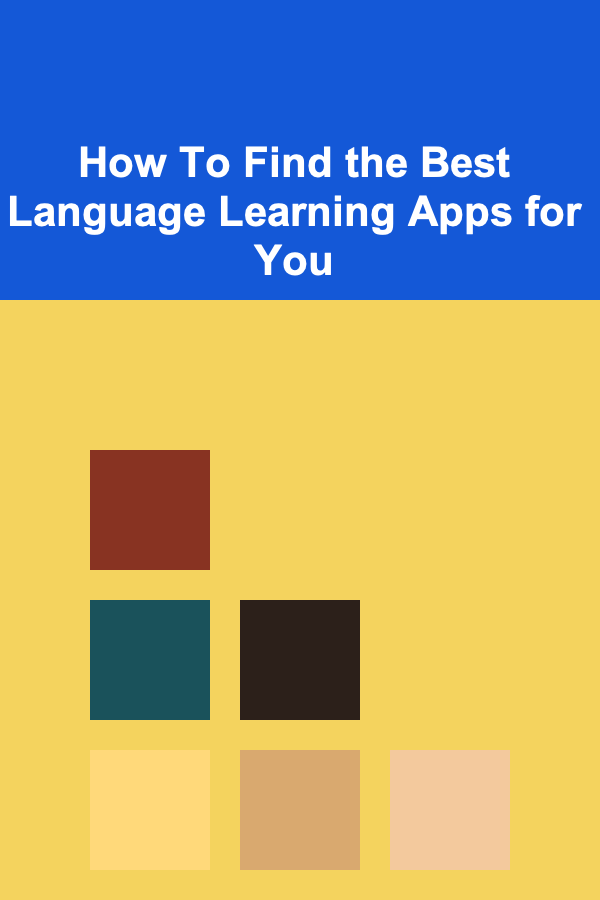
How To Find the Best Language Learning Apps for You
ebook include PDF & Audio bundle (Micro Guide)
$12.99$5.99
Limited Time Offer! Order within the next:

Learning a new language has become easier than ever before with the rise of technology, especially mobile applications designed to teach languages. With the multitude of language learning apps available today, finding the best one for your needs can be overwhelming. From beginners to advanced learners, there's something out there for everyone, but choosing the right app requires careful consideration of your goals, learning style, and the language you wish to learn. This article will guide you through how to select the best language learning app for you, based on a variety of factors that can enhance your language learning journey.
Understand Your Language Learning Goals
Before you begin searching for language learning apps, it's essential to understand your goals. Are you trying to become conversational in a short amount of time? Do you want to achieve fluency and proficiency? Are you learning for travel, business, or academic purposes? Understanding your specific needs will help you choose the right app tailored to your language learning objectives.
Short-Term vs. Long-Term Learning
If you're learning a language for a quick trip or travel, you may want an app that focuses on conversational skills, with practical phrases and vocabulary for everyday situations. Apps like Duolingo or Busuu provide quick, bite-sized lessons for learners who need to know basic language skills in a short time.
On the other hand, if you're aiming for long-term proficiency or fluency, you may want an app that offers more comprehensive grammar lessons, vocabulary building, and practice opportunities. Apps like Babbel or Pimsleur might be more suitable for a deeper language acquisition journey, offering structured lessons and in-depth explanations.
Specialized Needs
Consider whether you have any specialized learning needs. For example, are you learning a language for a specific professional field, like medicine or business? Apps like Memrise or Anki allow for customization, enabling learners to focus on professional jargon or specific topics of interest.
Determine Your Preferred Learning Style
Different people have different learning styles, and understanding yours can help you choose an app that supports your preferred method of learning. Some apps use traditional methods like reading and writing, while others incorporate more interactive or audio-based lessons. Here are a few common learning styles and how different apps align with them:
Visual Learners
If you are a visual learner, you may find apps that use images, charts, and visual cues more effective. Apps like Duolingo or Memrise use images alongside words to reinforce learning and help you remember vocabulary.
Auditory Learners
If you learn best by hearing, apps with audio features are a great choice. Apps like Pimsleur are perfect for auditory learners, as they emphasize listening and repeating. Rosetta Stone also offers immersive language experiences through its use of audio prompts and repetition.
Kinesthetic Learners
For kinesthetic learners, who learn by doing and practicing, apps that focus on active practice and interaction with the language are ideal. Apps like HelloTalk or Tandem enable you to practice with native speakers, helping you to immerse yourself in real-life conversations and apply what you've learned.
Analytical Learners
If you're an analytical learner who enjoys understanding grammar rules and sentence structures, apps like Babbel provide more in-depth lessons that break down grammar, syntax, and vocabulary in detail.
Assess the Features of the App
Different language learning apps offer different features. When selecting an app, it's crucial to assess what features will most benefit your learning style and goals. Below are some key features to consider when evaluating language learning apps.
Speech Recognition
Many apps now offer speech recognition technology, which helps you improve your pronunciation. Rosetta Stone is well-known for this feature, which uses your voice to compare against native speaker models. Apps like Babbel and Memrise also include pronunciation exercises that provide feedback.
Gamification
Gamification in language learning makes the process more engaging by turning lessons into games. Apps like Duolingo incorporate a gamified system with rewards, levels, and achievements, making it more motivating for learners to stick with their study routine.
Cultural Context
Language learning isn't just about vocabulary and grammar; understanding the culture associated with the language is also important. Apps like Clozemaster and Lingodeer offer not only language lessons but also help to immerse learners in cultural context, making the learning process more holistic.
Native Speaker Interaction
Apps like Tandem and HelloTalk allow learners to connect with native speakers. These platforms create an immersive experience where you can practice writing and speaking with people who are fluent in the language you're learning, providing real-world practice that can't be replaced by theoretical lessons alone.
Progress Tracking
Most apps offer some form of progress tracking, but some do it better than others. Look for an app that provides detailed statistics and feedback to help you stay on track. Babbel and Busuu both offer clear progress tracking, showing your strengths and areas where you need improvement.
Offline Capabilities
If you plan to learn while traveling or in areas without a strong internet connection, you might want to choose an app with offline capabilities. Apps like Duolingo and Babbel allow you to download lessons and practice offline, so you're never without your lessons.
Consider the Language Offered
Not all language learning apps offer every language. Some apps specialize in certain languages, while others cover a broader range. If you're learning a less common language, make sure the app you choose offers enough resources and content in that language.
Common Languages
If you are learning a widely spoken language like Spanish, French, or German, apps like Duolingo , Babbel , or Rosetta Stone are excellent choices. These apps offer extensive courses with a wide range of levels and learning materials.
Niche Languages
If you are interested in less common languages like Icelandic, Swahili, or Hebrew, you might want to consider specialized apps like Mango Languages or Clozemaster, which offer a wide variety of languages that aren't typically found on mainstream apps.
Evaluate the Cost
The price of language learning apps varies widely, with some offering free content while others require a paid subscription or one-time purchase. Be sure to evaluate your budget and determine how much you are willing to spend.
Free Apps
Many apps, like Duolingo , HelloTalk , and Clozemaster, offer free versions with the option to pay for additional features. While free apps can provide a good start to language learning, they may not offer the same level of depth and personalization as paid versions.
Paid Subscriptions
If you're looking for a more comprehensive learning experience, you might want to consider paid apps like Babbel , Pimsleur , or Rosetta Stone. These apps tend to have more in-depth lessons and features that are worth the investment if you're serious about language learning.
One-Time Purchase
Some apps, like Memrise, offer a one-time purchase option. This is ideal for learners who don't want a recurring subscription and prefer a more straightforward cost structure.
Look for Reviews and Recommendations
One of the best ways to determine if an app will work for you is to check reviews and recommendations from other users. Look for reviews on app stores, language learning forums, or blogs. Pay attention to user feedback on usability, effectiveness, and the features offered.
Community Recommendations
Websites and forums dedicated to language learning, such as Reddit's r/languagelearning or Fluent in 3 Months, often have user reviews and discussions about the best apps available. These platforms are a goldmine for finding recommendations from people who have experience using different language learning tools.
Expert Reviews
There are many experts in the language learning field who provide in-depth reviews of various language apps. Websites like Language Learning Stack Exchange and The Language Nerds provide expert opinions and comparisons between apps based on different criteria such as effectiveness, ease of use, and value for money.
Test It Yourself
Finally, the best way to determine which language learning app works for you is to try them out yourself. Many apps offer free trials or free versions with limited features, so you can get a feel for the app before committing to a paid subscription.
Experiment with different apps, see which interface you like, and assess whether the app aligns with your learning style and goals. Don't be afraid to switch between apps until you find the one that fits your needs perfectly.
Conclusion
Selecting the right language learning app requires an understanding of your goals, learning style, and preferred features. By assessing your needs and considering factors like language options, app features, cost, and user feedback, you can find the best app that will help you achieve language proficiency. Whether you want to learn for travel, business, or personal enrichment, there's an app out there that can support your learning journey.

How to Soundproof Your Home Without Major Construction
Read More
How to Start a Small Business and Use It as an Investment Vehicle
Read More
How to Train Your Pet for Basic Commands at Home
Read More
Navigating Compliance: A Practical Handbook for Officers
Read More
Healthy & Creative Pasta Sauces: Beyond the Jar
Read More
How to Track Daily Expenses Using Mobile Apps
Read MoreOther Products

How to Soundproof Your Home Without Major Construction
Read More
How to Start a Small Business and Use It as an Investment Vehicle
Read More
How to Train Your Pet for Basic Commands at Home
Read More
Navigating Compliance: A Practical Handbook for Officers
Read More
Healthy & Creative Pasta Sauces: Beyond the Jar
Read More